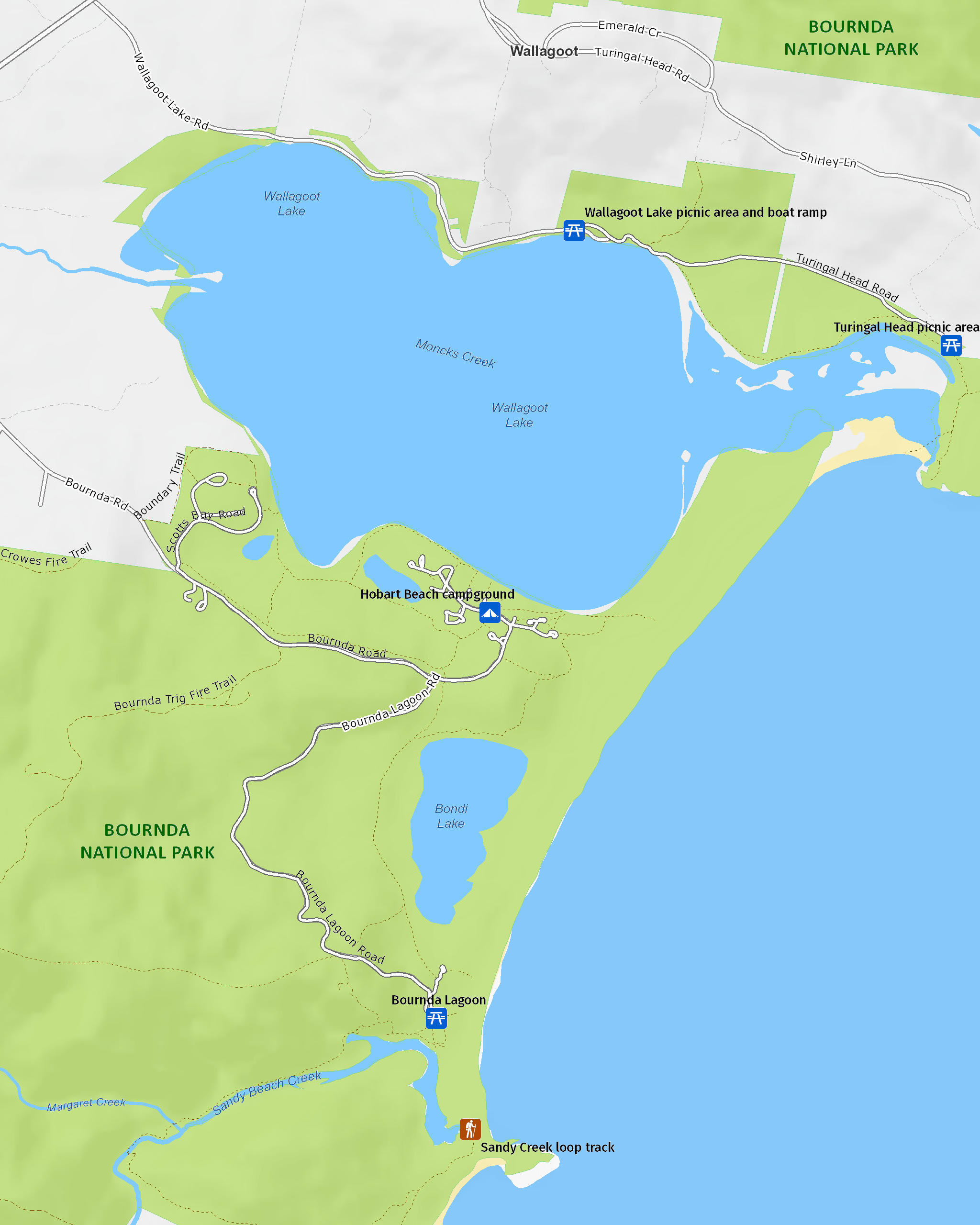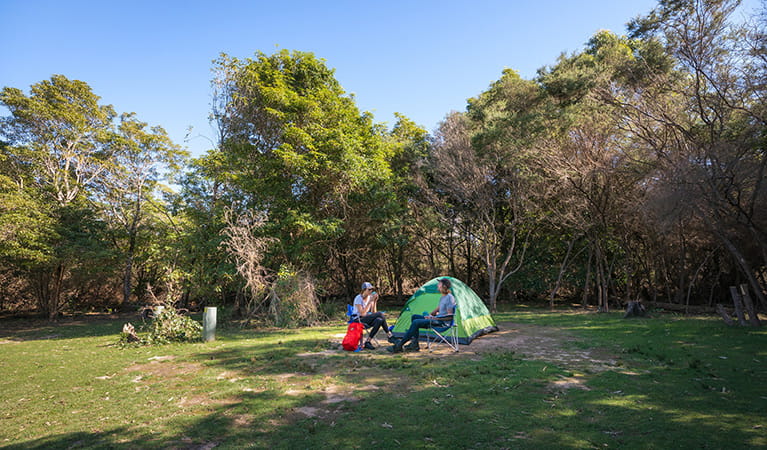Hobart Beach campground
Bournda National Park
Hobart Beach campground, near Bega, is a perfect coastal holiday offering swimming, fishing, paddling, and walking options for the whole family.
| Number of campsites | 66 |
|---|---|
| Camping type | Tent, Camper trailer site, Caravan site, Camping beside my vehicle |
| Where | 293 Bournda Road, Bournda, NSW, 2548 - in Bournda National Park |
| Facilities | Amenities block, picnic tables, barbecue facilities, carpark, showers, toilets |
| What to bring | Drinking water, cooking water, firewood |
| Entry fees |
Park entry fees are not included in your camping fees. |
| Group bookings | Book up to 40 people or 9 sites online. For larger groups, make a group booking enquiry. |
| Please note |
|
Pack the car with all your favourite outdoor camping equipment and head for the sandy shores of the idyllic Wallagoot Lake. Hobart Beach campground in Bournda National Park on the far south coast is a great destination for a family holiday.
Pitch the tent or park the van beside the shimmering waters fringed with forest. While you might have relaxing in mind, there are loads of activities to keep everyone happy. Spend your days swimming, walking, cycling, fishing and exploring nearby secluded beaches. The peaceful lake is ideal swimming for the little ones, while the northern shores of Wallagoot Lake are excellent for sailing and paddling.
If you’ve spent the day fishing, gather the clan for a relaxing barbecue of your daily catch and recount stories of the one that got away.
Map

Map legend

Local alerts
For the latest updates on fires, closures and other alerts in this area, see https://www.nationalparks.nsw.gov.au/camping-and-accommodation/campgrounds/hobart-beach-campground/local-alerts
Bookings
- National Parks Contact Centre
- 7am to 7pm daily
- 1300 072 757 (13000 PARKS) for the cost of a local call within Australia excluding mobiles
- parks.info@environment.nsw.gov.au
Operated by
- Merimbula office
- Monday to Friday and some weekends during peak holiday periods, 10am to 3pm.
- 02 6495 5000
- npws.sapphirecoast@environment.nsw.gov.au
- 47 Merimbula Drive, cnr Sapphire Coast Drive, Merimbula NSW 2548
Park info
- in Bournda National Park in the South Coast region
Bournda National Park is always open but may have to close at times due to extreme weather or fire danger.
-
Park entry fees:
$8 per vehicle per day. This park uses a self-registration fee collection system, please bring correct change.
Buy annual pass
Visitor info
All the practical information you need to know about Hobart Beach campground.
Getting there and parking
Hobart Beach campground is in the southern precinct of Bournda National Park. To get there, drive 14km north of Merimbula on the Sapphire Coast Drive, take the Bournda Road turnoff, and follow the signs.
Road quality
- There is a 40km speed limit on the long access road, which has sealed and unsealed sections.
- Take care as you drive - the road to the campground can rough at times.
- Mixture of sealed and unsealed roads
Vehicle access
- 2WD vehicles
Weather restrictions
- All weather
Parking
Parking is available at Hobart Beach campground directly at your campsite and on the gravel access road.
Best times to visit
There are lots of great things waiting for you in Bournda National Park. Here are some of the highlights.
Autumn
Hike along Kangarutha walking track as the weather cools and spend a day exploring the scenic coastal views that this walk has to offer. Swim along the way at secluded beaches where you'll feel like you have the place to yourself.
Spring
Enjoy the colours of wildflowers and the take in the smells of spring as the park comes alive. Head to the lookout at North Tura, find a sunny spot and look out for whales passing in the distance.
Summer
Discover the water activities on offer. Paddling at Bournda Lagoon, sailing on Wallagoot Lake, or fishing, surfing and swimming at any one of the secluded beaches.
Facilities
- There is a boat ramp at the Boat Club on the north side of Wallagoot Lake, however there are no boat ramp facilities at this campground.
- There is no water or firewood at this campground
Amenities
Toilets
There are 8 toilets throughout the campground, including accessible toilets at the centre of the campground.
- Non-flush toilets
Picnic tables
There are 2 picnic shelters.
Barbecue facilities
- Gas/electric barbecues (free)
Carpark
Showers
- Hot showers
Step-free access
The campground is flat and step-free, with concrete and paved pathways that lead to the amenities. You'll need to cross over hard-packed ground to reach the rest of the facilities.
All the trails that lead to the lake and the beach have steps or soft sand.
- Step-free outdoor pathways
Maps and downloads
Accessibility
Disability access level - medium
Hobart Beach campground is flat and step-free, with the following accessible facilities:
- Accessible non-flush toilets
- Accessible hot showers
There's a concrete and paved path that leads to the amenities. To reach the rest of the facilities, you'll need to cross over hard-packed ground.
All of the access trails that lead to the lake and beach have steps or soft sand.
Prohibited
Generators
Pets
Pets and domestic animals (other than certified assistance animals) are not permitted. Find out which regional parks allow dog walking and see the pets in parks policy for more information.
Smoking
NSW national parks are no smoking areas.
Learn more
Hobart Beach campground is in Bournda National Park. Here are just some of the reasons why this park is special:
Birdwatchers haven

With around 200 species of birds in the area, Bournda is a birdwatcher's paradise. The estuarine wetlands at the eastern end of Wallagoot Lake provide roosting and feeding areas for a large variety of waders and waterfowl. Keep your eyes out for threatened species like the little tern, hooded plover and pied oystercatcher. Bondi Lake is the largest freshwater lake situated behind coastal dunes in the region, and is another important habitat for waterbirds.
- Bournda Lagoon Bournda Lagoon is an ideal spot within Bournda National Park, near North Tura, where kids can swim, fish and go paddling and picnic among the paper barks.
- Kangarutha walking track Kangarutha walking track, in Bournda National Park, is a hiking route with scenic coastal views and birdwatching, picnicking and swimming opportunities along the way.
- Sandy Creek loop track Taking in Bournda Lagoon, Sandy Creek and pockets of dry sclerophyll forest, Sandy Creek loop track is a hike in Bournda National Park on the far South Coast.
Get active

With so much to do, there's no excuse not to get active in Bournda. The beaches and waterways offer a range of options for watersport enthusiasts - waterskiing, boating, paddling, sail boarding, fishing, swimming and surfing. The coastal walk is perfect for hikers and those hoping to spot migrating whales. And for cyclists, the roads throughout the park are an extensive network to navigate on your bike.
- Living Country, living culture Join us for Living Country, living culture – a Stage 3 Geography excursion in Bournda National Park. In this cross-curricular program, an Aboriginal guide will help students understand the importance of culture and caring for Country.
- Living Country, living culture Join us for Living Country, Living Culture – a Stage 2 History excursion in Bournda National Park. In this cross-curricular program, an Aboriginal guide will help students understand the importance of culture and caring for Country.
- Living Country, living culture Join us for Living Country, living culture – a Stage 1 History excursion in Bournda National Park. In this cross-curricular program, an Aboriginal guide will help students understand the importance of culture and caring for Country.
Ships ahoy

There's plenty of fascinating heritage in Bournda, dating back to the 1830s when European settlement of the district began. Today, you can still see anchor bolts at Kangarutha Point, which was established as a port with Kianinny Bay in 1859. It's also believed the existing track to the point, and parts of the coastal walk, were once used to supply ships anchored there, and transport produce and passengers. Some building remains can also be found around Games Bay, which was cleared for dairy farming by settler Mr Games.
The land of generations

Bournda has been a special place for the Dhurga and Yuin people for thousands of years, with its plentiful food supply and quarry for making tools. As you explore the park and its wildlife, it'll be no surprise that 'Bournda' means 'place of tea tree and kangaroos'.
- Living Country, living culture Join us for Living Country, living culture – a Stage 3 Geography excursion in Bournda National Park. In this cross-curricular program, an Aboriginal guide will help students understand the importance of culture and caring for Country.
- Living Country, living culture Join us for Living Country, Living Culture – a Stage 2 History excursion in Bournda National Park. In this cross-curricular program, an Aboriginal guide will help students understand the importance of culture and caring for Country.
- Living Country, living culture Join us for Living Country, living culture – a Stage 1 History excursion in Bournda National Park. In this cross-curricular program, an Aboriginal guide will help students understand the importance of culture and caring for Country.
- Traditional weaving workshop: Bournda Get creative on a traditional weaving workshop in Bournda National Park, near Bega and Merimbula. Learn Aboriginal weaving techniques and see how these ancient skills carry a strong connection to Aboriginal culture.
Education resources (1)
School excursions (3)
Bookings
- National Parks Contact Centre
- 7am to 7pm daily
- 1300 072 757 (13000 PARKS) for the cost of a local call within Australia excluding mobiles
- parks.info@environment.nsw.gov.au
Operated by
- Merimbula office
- Monday to Friday and some weekends during peak holiday periods, 10am to 3pm.
- 02 6495 5000
- npws.sapphirecoast@environment.nsw.gov.au
- 47 Merimbula Drive, cnr Sapphire Coast Drive, Merimbula NSW 2548
Park info
- in Bournda National Park in the South Coast region
Bournda National Park is always open but may have to close at times due to extreme weather or fire danger.
-
Park entry fees:
$8 per vehicle per day. This park uses a self-registration fee collection system, please bring correct change.
Buy annual pass
What's nearby:
Things to do (29)
- Aboriginal culture (4)
- Birdwatching and wildlife encounters (14)
- Canoeing/paddling (6)
- Fishing (11)
- Historic heritage (1)
- Photography (1)
- Picnics and barbecues (10)
- Sailing, boating and cruises (1)
- Sightseeing (13)
- Snorkelling and scuba (1)
- Surfing (4)
- Swimming (8)
- Walking (10)
- Waterfalls (2)

